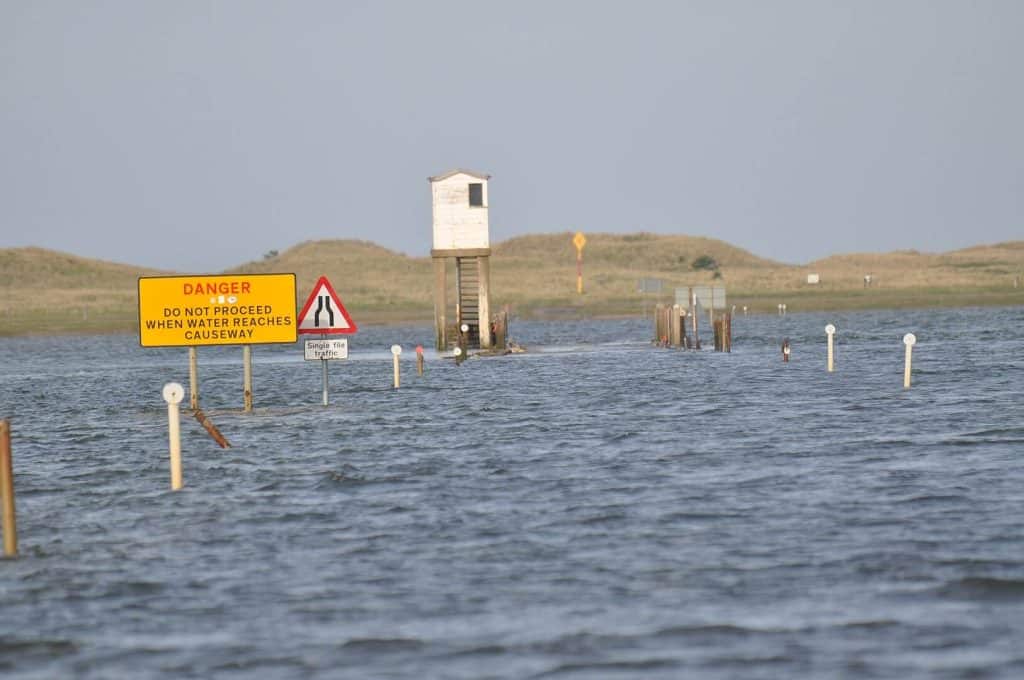
A few miles south of the Scottish border, in the English county of Northumberland, is where you’ll find the Lindisfarne Causeway. Furthermore, this is the road that disappears twice daily with the tides. It is located on Lindisfarne, near the Holy Island. This road leads to this little island, which is encircled by a stunning coastal landscape as you could imagine.
Where is Lindisfarne Causeway road located?
The stunning and historic island of Lindisfarne, also known as Holy Island, is located off the coast of Northumberland, England. It is home to the Lindisfarne Causeway. Only accessible at low tide, this road links the mainland and the island. The causeway offers a fantastic coastal experience and a one-of-a-kind opportunity to drive on a road that vanishes with the incoming tide. It is surrounded by enormous tidal mudflats. The road is well-maintained and provides picturesque views of the North Sea and the lovely Northumberland coastal landscape.
You can locate this road on the map below:
Enlarge the map
Information about this road :
Only accessible at low tide, the Lindisfarne Causeway is a road that links the mainland to the island. The causeway offers a breathtaking coastal experience and a one-of-a-kind opportunity to drive on a road that vanishes with the incoming tide. It is surrounded by vast tidal mudflats. The road is well-maintained and provides picturesque views of the North Sea and the lovely Northumberland coastal landscape.
What is the history of the Lindisfarne Causeway?
The history and legends of Lindisfarne Island are rich, ranging from the Viking raids of the seventh century to Saint Aidan’s founding of a monastery in the sixth century. It is a popular destination for pilgrims. The island’s many attractions, such as the ruins of Lindisfarne Priory, the 16th-century castle, and the neighborhood pubs and shops that provide a window into island life, are easily accessible thanks to the causeway.
Lindisfarne Causeway road preview:
You should be aware that the causeway becomes slick since the road floods twice daily.
You can obviously have a preview of that drive. Here is a YouTube video that shows a part of the road:
How to get to Lindisfarne Causeway road?
If you are coming from the north, for example from Edimbourg, take the A1 to Beal. Here starts the road. And if you are driving from the south, for example, Newcastle upon Tyne.
Also, if you are driving to Scotland, don’t forget to drive the North Coast 500, the A939 road, or the Great Dun Fell road if you go to England.

Is Lindisfarne Causeway road open?
The Lindisfarne Causeway is only open for a few hours on either side of low tide, making driving on it an adventure in and of itself. Before starting their journey, visitors are advised to check the tides because the causeway can quickly become impassable as the tide comes in. Two hours prior to high tide and up to three after it, the road is closed off. Despite being only a short distance, the drive offers a singular and unforgettable experience while being surrounded by the stunning coast’s natural beauty and the island’s extensive history. You can check the opening hours on this website.
In conclusion, anyone traveling to Northumberland should not skip the Lindisfarne Causeway. This road offers something for everyone. Whether you’re a history enthusiast, a nature enthusiast, or just looking for a special road trip experience. So get ready to embark on a journey to explore Lindisfarne Island’s beauty and history by packing your bags, grabbing your keys, and taking off.
Picture credit: By Causeway from Holy Island to the Mainland by Christine Matthews, CC BY-SA 2.0, https://commons.wikimedia.org/w/index.php?curid=106452227 / By Holy Island causeway at high tide by Nick Mutton, CC BY-SA 2.0, https://commons.wikimedia.org/w/index.php?curid=103910168
Discover other roads around the world: click here


